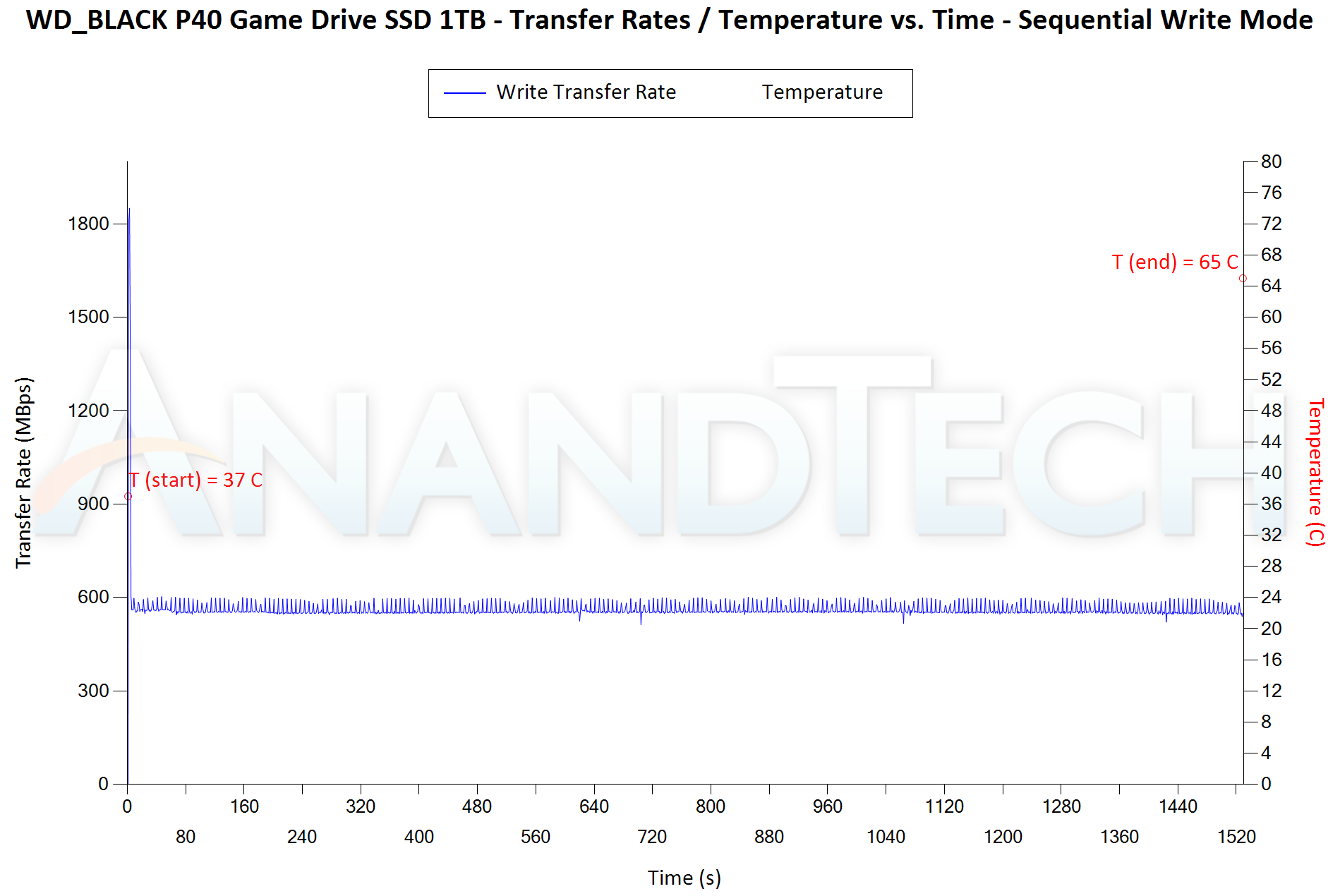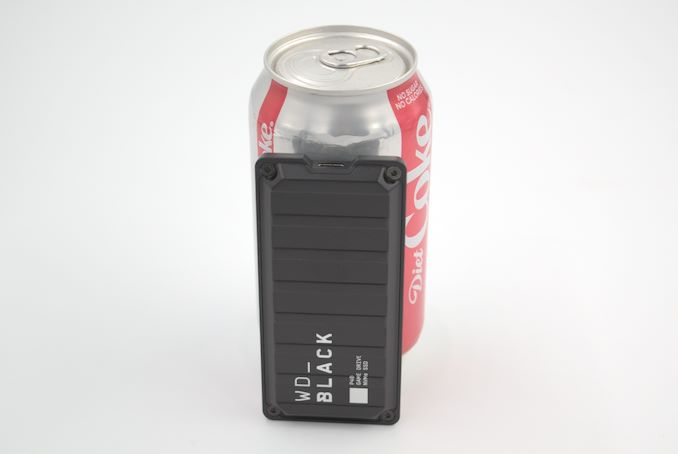WD_BLACK P40 Game Drive USB 3.2 Gen 2x2 Portable SSD Review: Balanced Storage
by Ganesh T S on November 18, 2022 8:00 AM ESTMiscellaneous Aspects and Concluding Remarks
The performance of the storage bridges / drives in various real-world access traces as well as synthetic workloads was brought out in the preceding sections. We also looked at the performance consistency for these cases. Power users may also be interested in performance consistency under worst-case conditions, as well as drive power consumption. The latter is also important when used with battery powered devices such as notebooks and smartphones. Pricing is also an important aspect. We analyze each of these in detail below.
Worst-Case Performance Consistency
Flash-based storage devices tend to slow down in unpredictable ways when subject to a large number of small-sized random writes. Many benchmarks use that scheme to pre-condition devices prior to the actual testing in order to get a worst-case representative number. Fortunately, such workloads are uncommon for direct-attached storage devices, where workloads are largely sequential in nature. Use of SLC caching as well as firmware caps to prevent overheating may cause drop in write speeds when a flash-based DAS device is subject to sustained sequential writes.
Our Sequential Writes Performance Consistency Test configures the device as a raw physical disk (after deleting configured volumes). A fio workload is set up to write sequential data to the raw drive with a block size of 128K and iodepth of 32 to cover 90% of the drive capacity. The internal temperature is recorded at either end of the workload, while the instantaneous write data rate and cumulative total write data amount are recorded at 1-second intervals.
| Sequential Writes to 90% Capacity - Performance Consistency | |
| TOP: | BOTTOM: |
 |
|
 |
|
The WD_BLACK P40 can sustain its advertised numbers for around 3 seconds before running out of SLC cache (this is with an empty drive). This translates to around 5.5 GB of SLC cache. Any data span beyond this results in a performance drop (down to the 600 MBps range). Only the Kingston XS2000 has a worse performance profile in this test, but that has the excuse of sporting a native UFD controller.
Power Consumption
Bus-powered devices can configure themselves to operate within the power delivery constraints of the host port. While Thunderbolt ports are guaranteed to supply up to 15W for client devices, USB 2.0 ports are guaranteed to deliver only 4.5W (900mA @ 5V). In this context, it is interesting to have a fine-grained look at the power consumption profile of the various external drives. Using the Plugable USBC-TKEY, the bus power consumption of the drives was tracked while processing the CrystalDiskMark workloads (separated by 5s intervals). The graphs below plot the instantaneous bus power consumption against time, while singling out the maximum and minimum power consumption numbers.
| CrystalDiskMark Workloads - Power Consumption | |
| TOP: | BOTTOM: |
 |
|
 |
|
The power consumption profile of the P40 is much better than the P50 despite the addition of the RGB lighting (which is on by default). A peak of 5.73W and a low-power idling state of 0.92W are good to see in a 20Gbps PSSD. The drive also enters the low-power state much quicker (5 minutes after last activity) compared to the P50 (around 20 minutes after last activity). A complete turn-off mode is implemented in the Seagate Firecuda (goes to around 0.2W) - that would be nice to see here. The Kingston XS2000 has a much lower power consumption number, but that is only expected given its single-chip UFD controller solution.
Pricing and Competitive Positioning
USB 3.2 Gen 2x2 PSSDs generally carry a pricing premium over the vanilla PSSDs. This has come down a bit after the introduction of native UFD controllers supporting the high-speed interface. With the WD_BLACK P40, Western Digital has brought down the pricing to normal USB 3.2 Gen 2 PSSD levels of last year.
The 1TB version evaluated above comes in at $130. At a similar capacity point, the P50 lands at $200. The XS2000 is obviously cheaper at $110, while the FireCuda is priced at $190. In terms of pricing, the P40 is hard to beat. For read-heavy workloads, it is a no-brainer. For writes, it performs better than the XS2000 over the whole drive span. However, for typical game sizes between 10GB and 100GB, the transfer time to the XS2000 is bound to be shorter given its 98GB SLC cache. The XS2000 also doesn't have RGB lighting - so the P40 has a slight edge here in the gaming market.
Final Words
The WD_BLACK P40 Game Drive is an interesting budget addition to the gaming-targeted lineup. The lack of performance consistency in writing out huge amounts of data (common when transferring large Steam libraries between systems, for example) is a deal-breaker for performance enthusiasts. However, the drive is able to make use of the high-speed interface well when reading out data. So, the drive could still be beneficial to a subset of the gaming crowd - folks who rarely write out whole games to the drive, but play thenm directly off the PSSD. A segment of gamers may also appreciate the infusion of RGB lighting. The drive is also a solid mid-range performer for traditional use-cases as shown in the PCMark storage workloads.
The most attractive feature of the drive is the pricing. Our recommendation for overall performance and feature set for gamers looking to purchase a USB 3.2 Gen 2x2 drive continues to be the WD_BLACK P50. The SanDisk Extreme PRO v2 (targeting a different market segment) will probably be a better bet if a fancy industrial design, RGB, and other gamers-desired features are not essential. Western Digital offers PSSDs tuned for different price points in a wide range of markets. In that context, the P40 fills an important hole in the company's portfolio even though it might not take the performance crown.











6 Comments
View All Comments
TheCurve - Saturday, November 19, 2022 - link
Loved this review! Direct, no fluff, just honest advice and dataAlB80 - Sunday, November 20, 2022 - link
Support for USB3 10Gbps x2 links are optional for USB4.hMunster - Monday, November 21, 2022 - link
Does OS X finally support TRIM on non-Thunderbolt external SSDs?Techie2 - Monday, December 5, 2022 - link
It's now December and not a single Gen 5 consumer SSD is being offered for sale. That's rather strange considering all the hoopla and claims that these drives would be available in Oct. '22.yifu - Tuesday, December 13, 2022 - link
we need to support anandtech, when innerfidelity went away, there is only commercials reviews. we need anandtech.com, we need some kind of honest authority, otherwise it's just chaos, and shit!!!I have allowed anandtech from ad blocker.
sonsjhon09 - Thursday, December 29, 2022 - link
I appreciate your work